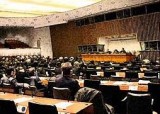UN General Assembly takes forward proposals from the UN Open Ended Working Group and reaffirms its decision to hold a High Level Conference on Nuclear Abolition
During the month of October the United Nations General Assembly considered a number of reports and resolutions on nuclear disarmament. Amongst these was the Report of the UN Secretary-General on ‘Taking Forward Multilateral Nuclear Disarmament Negotiations’, and a resolution by the same title that was adopted by the overwhelming majority of 152 in favour, 4 against and 22 abstentions.
The Report and Resolution follows-up the UN Open Ended Working Group (OEWG) on Taking Forward Multilateral Nuclear Disarmament Negotiations, which met during 2013 and produced a number of promising proposals to break the 18-year deadlock in such negotiations. The OEWG was supported by a global civil society Open the Door campaign.

Parliamentarians present to the OEWG
The Danish government reported that “The work of the Open-ended Working Group proved to be positive and productive. Member States engaged in open-minded and constructive dialogue. Positions and concepts were presented in new and less confrontational forms. A report presenting different and new approaches to nuclear disarmament voiced during the sessions was agreed by consensus and forwarded to the General Assembly…’ However, ‘No progress has been seen so far in 2014. In this light, convening a second Open-ended Working Group, with a view to deepening and broadening the deliberations of 2013 and building bridges across differences could be considered.’
The UN General Assembly decided not to hold further sessions of the OEWG in 2015 – perhaps due to most States wanting to focus on the 5-yearly review conference of the nuclear Non-Proliferation Treaty which will take place over four weeks in April-May 2015. However, the UNGA decided to review progress at the end of 2015, and it held open the possibility of further sessions of the OEWG after that if necessary..
In the meantime, the Resolution calls upon ‘Member States, international organizations and civil society to continue to enrich the discussions on how to take forward multilateral nuclear disarmament negotiations in the United Nations bodies in which disarmament and peace and security are addressed,’ and stressed that ‘as the most universal and most representative organization in the world, the United Nations must play the central role.’
UNFOLD ZERO, a recently launched initiative to advance UN-focused nuclear disarmament initiatives has taken up this call. UNFOLD ZERO promotes nuclear disarmament actions and initiatives in the UN Security Council, General Assembly, International Court of Justice, Human Rights Council and International Criminal Court. UNFOLD ZERO also highlights the role of the UN Secretary-General and UN Office of Disarmament Affairs and coordinates actions around the world including for the first International Day for the Total Elimination of Nuclear Weapons.
On October 28, UNFOLD ZERO presented some of these initiatives and actions at the United Nations in an event co-sponsored by the governments of Costa Rica, Finland, Indonesia and Kazakhstan. The event included discussion of the High Level Conference on Nuclear Disarmament which the UN re-affirmed would be held no later than 2018. It is hoped that proposals generated from the OEWG will result in the adoption of a nuclear disarmament treaty at the 2018 conference. This could be a significant agreement, such as a framework convention, a use-ban (or a lesser no-first-use agreement), a ban treaty or a framework for negotiating a nuclear weapons convention. (See Perfect storm for a breakthrough, paper presented by Aaron Tovish, Mayors for Peace).
In 2012, in order to help build agreement on such proposals, the Middle Powers Initiative and Parliamentarians for Nuclear Non-proliferation and Disarmament established the Framework Forum. A series of track-two Framework Forum meetings of governments, parliamentarians and disarmament experts has been held in Vienna, Berlin, Geneva and New York to explore the proposals and build political support to move from the proposals to actual negotiations. Two of these focused specifically on the OEWG and its proposals. See Framework Forum brings governments and experts together in Geneva to ‘walk through the door’ to a nuclear weapons free world and Governments and experts meet in 'Framework Forum' to discuss key proposals and new initiatives for nuclear disarmament.

Framework Forum meeting in Berlin, Feb 2013
In addition to the proposals mentioned above, the Framework Forum has been exploring the ‘Building Blocks’ proposal, which was submitted to the OEWG by a group of countries including Australia, Belgium, Canada, Colombia, Czech Republic, Denmark, Estonia, Finland, Germany, Hungary, Italy, Japan, Lithuania, Netherlands, Poland, Portugal, Slovakia, Spain, Sweden and Ukraine. Denmark argued that the Building Blocks proposal ‘endeavours to overcome the gap between the so-called “step-by-step” and “comprehensive” approaches and merits further consideration.
The Costa Rican government, which chaired the OEWG, noted that the “building blocks” proposal enjoyed broad support in the Working Group. This is a different concept from the “step-by-step” approach, because it requires only that the elements needed to achieve nuclear disarmament be identified. These building blocks are not dependent on one another and are not linked in a time sequence.

Participants at the Building Blocks roundtable, United Nations, 22 October 2014
The Building Blocks proposal was explored at a roundtable at the United Nations on October 22. See Using “Building Blocks” To Construct a World Free of Nuclear Weapons. Ambassador Yamamoto (Japan) likened the path to a nuclear-weapon-free world as being like climbing Mount Fuji – which has multiple paths to the top all supported by well-built steps and supporting measures.
Alyn Ware, PNND Global Coordinator, remarked that “We used to say that getting to a nuclear-weapon-free world was like climbing Mount Everest – a long and technically difficult climb that will take good planning and many steps. Indeed, from where we stand now, the top still seems covered in clouds and the path still unknown. However, the analogy of climbing Mount Fuji is probably more accurate, with many of the steps already in place, a range of paths to the top and the possibility for everyone to get there.”

